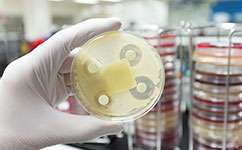Sewage treatment contributes to antibiotic resistance

Wastewater treatment plants are unwittingly helping to spread antibiotic resistance, say scientists.
Researchers found that processing human, farm and industrial waste all together in one place makes it easier for bacteria to become resistant to a wide range of even the most clinically-effective antibiotics.
This is because so many different types of bacteria come together in sewage plants that it gives them a perfect opportunity to swap genes that confer resistance, helping them live. This means antibiotic-resistant bacteria are evolving much faster than they would in isolation.
The research, published in Journal of Antimicrobial Chemotherapy, says the situation is creating reservoirs of highly resistant gut bacteria in the environment, threatening human and animal health.
It suggests we urgently need to find new ways to process waste more effectively so we're not inadvertently breeding drug-resistant bacteria.
'The way sewage plants mix up different types of waste means they're hotspots, helping bacteria share genes that mean they can deactivate or disarm antibiotics that would normally kill them,' says Professor Elizabeth Wellington of the University of Warwick, who led the study.
Earlier studies have suggested that farming and waste processing methods contribute to reservoirs of resistant bacteria in the environment. But, until now, very few studies had looked at whether or not wastewater effluent contributes to the problem.
'A greater volume of antibiotics is used in farming than in anything else. Huge amounts are used globally, mainly for treating infections in food animals but also to promote growth,' Wellington says.
She and colleagues from the universities of Warwick and Birmingham and the Health Protection Agency decided to see if they could find any of these bacteria near wastewater treatment plants. They analysed sediment samples from both upstream and downstream of a sewage works.
They found many more bacteria resistant to a class of clinically-important antibiotics called third-generation cephalosporins (3GC) in downstream water.
These drugs are broad-spectrum antibiotics used to treat a whole range of problems, including meningitis, septicaemia, and so-called hospital-acquired infections.
Most worryingly, the scientists found that 3GC-resistant E. coli were seven times more common downstream of a UK sewage plant than upstream.
'Our findings suggest that resistance is spreading, because of a gene called blaCTX-M-15. This gene is carried on a mobile genetic element called a plasmid. Bacteria collect these genes to allow them to adapt to their environment,' says Wellington.
'This is a big deal, because this is the most common bacterial antibiotic resistance gene causing failures in treatment of infections, and it's the first time anyone has seen this gene in UK rivers. The problem is we're use river water to irrigate crops, people swim or canoe in rivers, and both wildlife and food animals come into contact with river water.'
'These bacteria also spread during flooding. And with more flooding and heavy rain, this could get worse.'
A previous study found that a third of people swimming in areas of the River Thames come down with some kind of stomach bug, highlighting the threat to human health posed by rivers. 'You really run the risk of getting gastroenteritis,' added Wellington.
As well as finding antibiotic-resistant bacteria downstream of the sewage plant, Wellington and her colleagues found E. coli which has become resistant to a less commonly used antibiotic called imipenem in the same region of the river - the first time such bacteria have been found in the wild.
Ticking timebomb
'We've completely underestimated the role waste treatment processes play in antibiotic resistance,' says Wellington.
'Stricter regulations and higher levels of treatment are needed if we are to halt the rise in antibiotic resistance in the environment,' write the authors in their report.
'We're now looking at ways to get wastewater treatment plant effluent cleaner,' says Wellington. 'But we're keen not to point the finger at these plants. There's contribution from everywhere.'
In 2013, Chief Medical Officer for England, Prof Dame Sally Davies, described the threat of antimicrobial resistance as a ticking timebomb, adding that it's as much of a threat as terrorism.
'We're on the brink of Armageddon and this is just contributing to it,' Wellington says. 'Antibiotics could just stop working and we could all be colonised by antibiotic-resistant bacteria.'
More information: G. C. A. Amos, P. M. Hawkey, W. H. Gaze and E. M. Wellington, "Waste water effluent contributes to the dissemination of CTX-M-15 in the natural environment," Journal of Antimicrobial Chemotherapy 2014; 69: 1785 - 1791, published online 5th May 2014, DOI: 10.1093/jac/dku079
This story is republished courtesy of Planet Earth online, a free, companion website to the award-winning magazine Planet Earth published and funded by the Natural Environment Research Council (NERC).



















